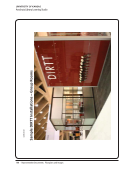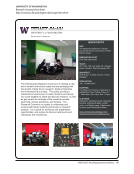28 · Survey Results: Survey Questions and Responses
The Biology and Math libraries were closed in 2009. Service is now provided in the main library by the Biology and Math
Subject Librarian.
The circulation and reserve desks were combined. However, the microform, media, and music monument collections
remained behind. We are currently planning for microform equipment to move to an area where an existing service
point can provide support and we are making plans for making the media and monuments collections open and self-
service. We also added a new service point—the Teaching Commons—but we did not use staff from either of the
consolidated service points to do so.
The education library had long occupied a space within the education school belonging to that school. In collaboration
with the ed school, the library space was reconfigured to something like a learning commons. Except for reference
handbooks, the juvenile book collection, and a small area to hold recalled books, the physical collections were moved to
the main library creating an open space for student and faculty collaboration. The computer lab was retained, and the
equipment was purchased, and is now maintained, by the school.
The Library and Information Science Library was closed and a “virtual library” was established, along with an
“embedded librarian” service approach for the subject specialist, and the integration of core collection materials into
remaining physical units.
The library created a new media services department and its service desk was located where there was a previous
service point, but that service point (periodicals) was eliminated.
The library serving physics, chemistry, and the preclinical sciences was closed and services are now delivered at the Main
Library.
The media collection moved from an in-house use model to an open access, circulating model (with some media housed
in a closed area behind circulation) on the most public floor of the library.
The MIT Libraries recently reorganized. Our previous organization had a ‘divisional library’ structure where there were
libraries aligned with each of MIT’s schools or divisions, each with its own facility and acting as its own organizational
entity. Now, access services functions in each of these four buildings are managed by one department, the new
Information Delivery &Library Access department. These changes are largely organizational and few patrons have
noticed. Prior to the start of the reorganization, our organization went through two years of budget cuts, layoffs, and
mandatory furloughs.
The Periodicals Desk was closed once the current periodicals collection was moved to a different floor across from the
Circulation Desk. The Media Desk was moved to the former Periodicals Desk and the Media staff now provide service
for the microfilm collection which remains in the space it always has been.
The reference and circulation desks were integrated so that all public service operations are done at a single service
point in all our unit libraries. We had initiated this transition at our larger unit libraries first, and the four smaller units
made the transition two years ago.
The reference desk in Zimmerman Library: the largest was shutdown at the end of 2007 and in January 2008 the
Combined Service Point was born with Reference moving into the Circulation area. The reorganization later that year
created the Access Services Unit and the responsibility for the Circulation and Reference area became the responsibility
of the director of Access Services. In the spirit of declining staff resources (in number and reference expertise) and
dueling outreach/data librarian responsibilities, the reference desk at the science and engineering branch was closed in
2009 and the circulation desk was renovated to accommodate reference consultations. The University Libraries Virtual
Service Desk became the responsibility of Access Services in 2009. The VSD is staffed by UL staff from all four branches.
The Biology and Math libraries were closed in 2009. Service is now provided in the main library by the Biology and Math
Subject Librarian.
The circulation and reserve desks were combined. However, the microform, media, and music monument collections
remained behind. We are currently planning for microform equipment to move to an area where an existing service
point can provide support and we are making plans for making the media and monuments collections open and self-
service. We also added a new service point—the Teaching Commons—but we did not use staff from either of the
consolidated service points to do so.
The education library had long occupied a space within the education school belonging to that school. In collaboration
with the ed school, the library space was reconfigured to something like a learning commons. Except for reference
handbooks, the juvenile book collection, and a small area to hold recalled books, the physical collections were moved to
the main library creating an open space for student and faculty collaboration. The computer lab was retained, and the
equipment was purchased, and is now maintained, by the school.
The Library and Information Science Library was closed and a “virtual library” was established, along with an
“embedded librarian” service approach for the subject specialist, and the integration of core collection materials into
remaining physical units.
The library created a new media services department and its service desk was located where there was a previous
service point, but that service point (periodicals) was eliminated.
The library serving physics, chemistry, and the preclinical sciences was closed and services are now delivered at the Main
Library.
The media collection moved from an in-house use model to an open access, circulating model (with some media housed
in a closed area behind circulation) on the most public floor of the library.
The MIT Libraries recently reorganized. Our previous organization had a ‘divisional library’ structure where there were
libraries aligned with each of MIT’s schools or divisions, each with its own facility and acting as its own organizational
entity. Now, access services functions in each of these four buildings are managed by one department, the new
Information Delivery &Library Access department. These changes are largely organizational and few patrons have
noticed. Prior to the start of the reorganization, our organization went through two years of budget cuts, layoffs, and
mandatory furloughs.
The Periodicals Desk was closed once the current periodicals collection was moved to a different floor across from the
Circulation Desk. The Media Desk was moved to the former Periodicals Desk and the Media staff now provide service
for the microfilm collection which remains in the space it always has been.
The reference and circulation desks were integrated so that all public service operations are done at a single service
point in all our unit libraries. We had initiated this transition at our larger unit libraries first, and the four smaller units
made the transition two years ago.
The reference desk in Zimmerman Library: the largest was shutdown at the end of 2007 and in January 2008 the
Combined Service Point was born with Reference moving into the Circulation area. The reorganization later that year
created the Access Services Unit and the responsibility for the Circulation and Reference area became the responsibility
of the director of Access Services. In the spirit of declining staff resources (in number and reference expertise) and
dueling outreach/data librarian responsibilities, the reference desk at the science and engineering branch was closed in
2009 and the circulation desk was renovated to accommodate reference consultations. The University Libraries Virtual
Service Desk became the responsibility of Access Services in 2009. The VSD is staffed by UL staff from all four branches.






















































































































































































































